IBM's Business Practices and Strategy
VerifiedAdded on 2020/04/01
|15
|4465
|44
AI Summary
This assignment delves into the diverse facets of IBM's business practices. It examines their organizational structure, human resource management strategies, implementation of open innovation, and commitment to environmental sustainability within their supply chain. The analysis utilizes various frameworks like SWOT analysis and explores how these practices contribute to IBM's overall success and competitive advantage.
Contribute Materials
Your contribution can guide someone’s learning journey. Share your
documents today.
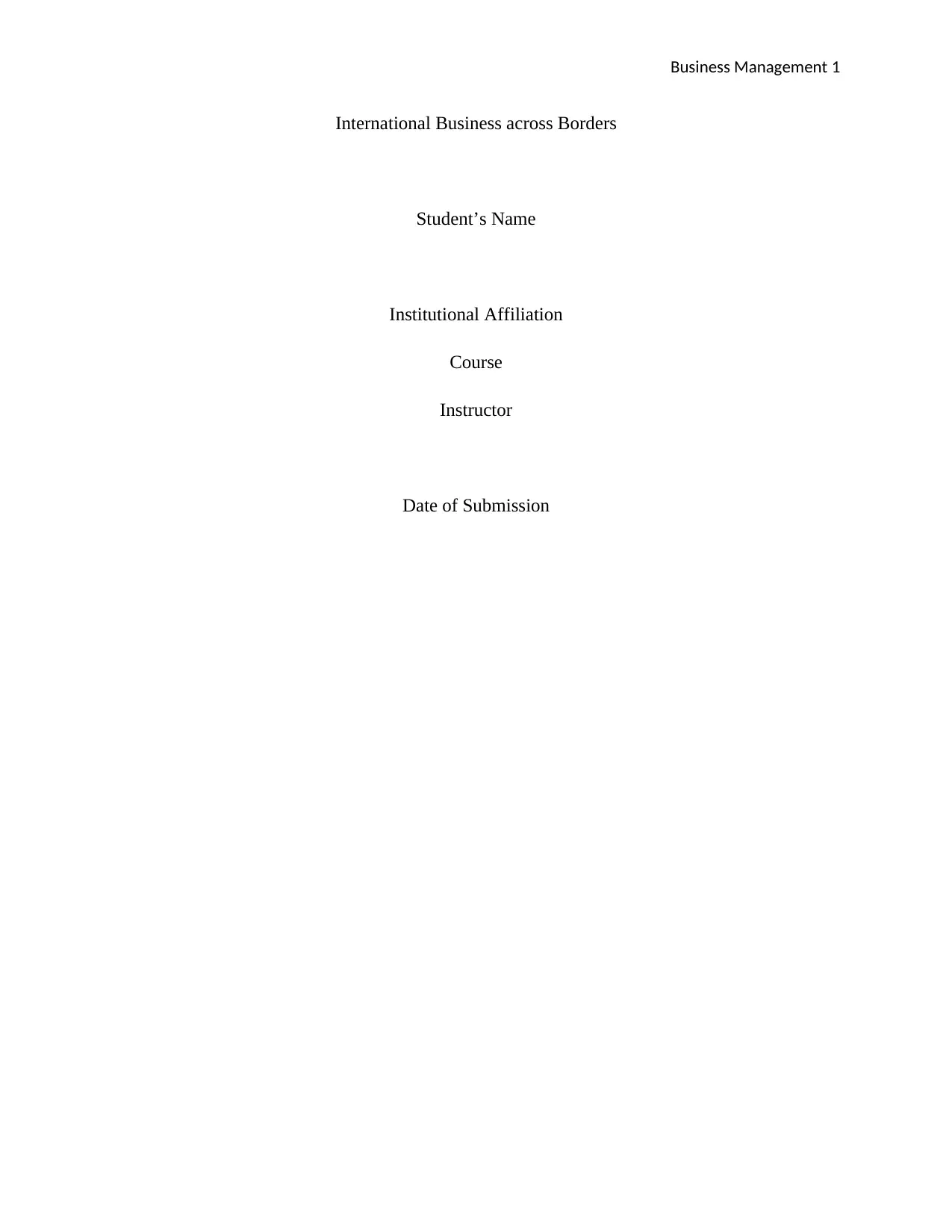
Business Management 1
International Business across Borders
Student’s Name
Institutional Affiliation
Course
Instructor
Date of Submission
International Business across Borders
Student’s Name
Institutional Affiliation
Course
Instructor
Date of Submission
Secure Best Marks with AI Grader
Need help grading? Try our AI Grader for instant feedback on your assignments.
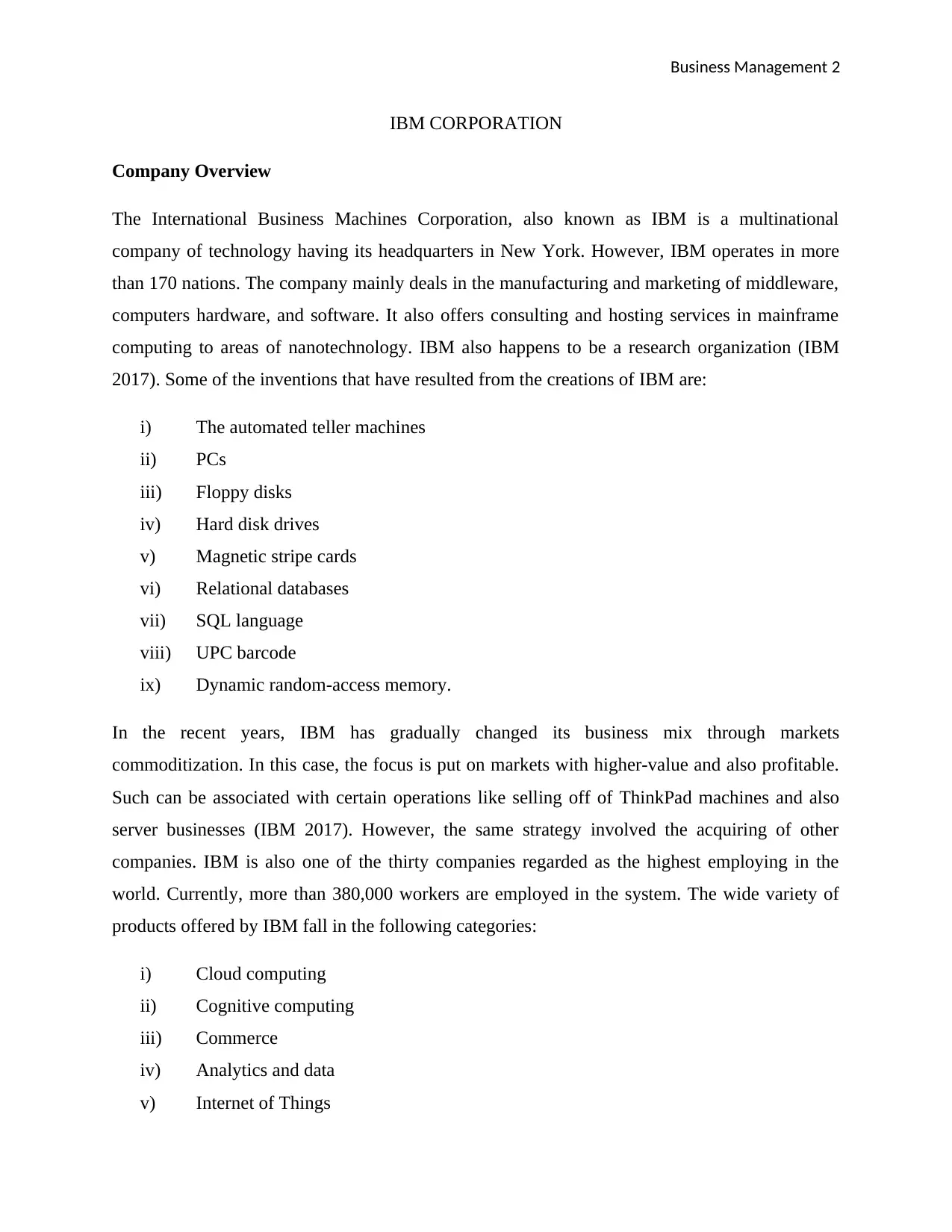
Business Management 2
IBM CORPORATION
Company Overview
The International Business Machines Corporation, also known as IBM is a multinational
company of technology having its headquarters in New York. However, IBM operates in more
than 170 nations. The company mainly deals in the manufacturing and marketing of middleware,
computers hardware, and software. It also offers consulting and hosting services in mainframe
computing to areas of nanotechnology. IBM also happens to be a research organization (IBM
2017). Some of the inventions that have resulted from the creations of IBM are:
i) The automated teller machines
ii) PCs
iii) Floppy disks
iv) Hard disk drives
v) Magnetic stripe cards
vi) Relational databases
vii) SQL language
viii) UPC barcode
ix) Dynamic random-access memory.
In the recent years, IBM has gradually changed its business mix through markets
commoditization. In this case, the focus is put on markets with higher-value and also profitable.
Such can be associated with certain operations like selling off of ThinkPad machines and also
server businesses (IBM 2017). However, the same strategy involved the acquiring of other
companies. IBM is also one of the thirty companies regarded as the highest employing in the
world. Currently, more than 380,000 workers are employed in the system. The wide variety of
products offered by IBM fall in the following categories:
i) Cloud computing
ii) Cognitive computing
iii) Commerce
iv) Analytics and data
v) Internet of Things
IBM CORPORATION
Company Overview
The International Business Machines Corporation, also known as IBM is a multinational
company of technology having its headquarters in New York. However, IBM operates in more
than 170 nations. The company mainly deals in the manufacturing and marketing of middleware,
computers hardware, and software. It also offers consulting and hosting services in mainframe
computing to areas of nanotechnology. IBM also happens to be a research organization (IBM
2017). Some of the inventions that have resulted from the creations of IBM are:
i) The automated teller machines
ii) PCs
iii) Floppy disks
iv) Hard disk drives
v) Magnetic stripe cards
vi) Relational databases
vii) SQL language
viii) UPC barcode
ix) Dynamic random-access memory.
In the recent years, IBM has gradually changed its business mix through markets
commoditization. In this case, the focus is put on markets with higher-value and also profitable.
Such can be associated with certain operations like selling off of ThinkPad machines and also
server businesses (IBM 2017). However, the same strategy involved the acquiring of other
companies. IBM is also one of the thirty companies regarded as the highest employing in the
world. Currently, more than 380,000 workers are employed in the system. The wide variety of
products offered by IBM fall in the following categories:
i) Cloud computing
ii) Cognitive computing
iii) Commerce
iv) Analytics and data
v) Internet of Things
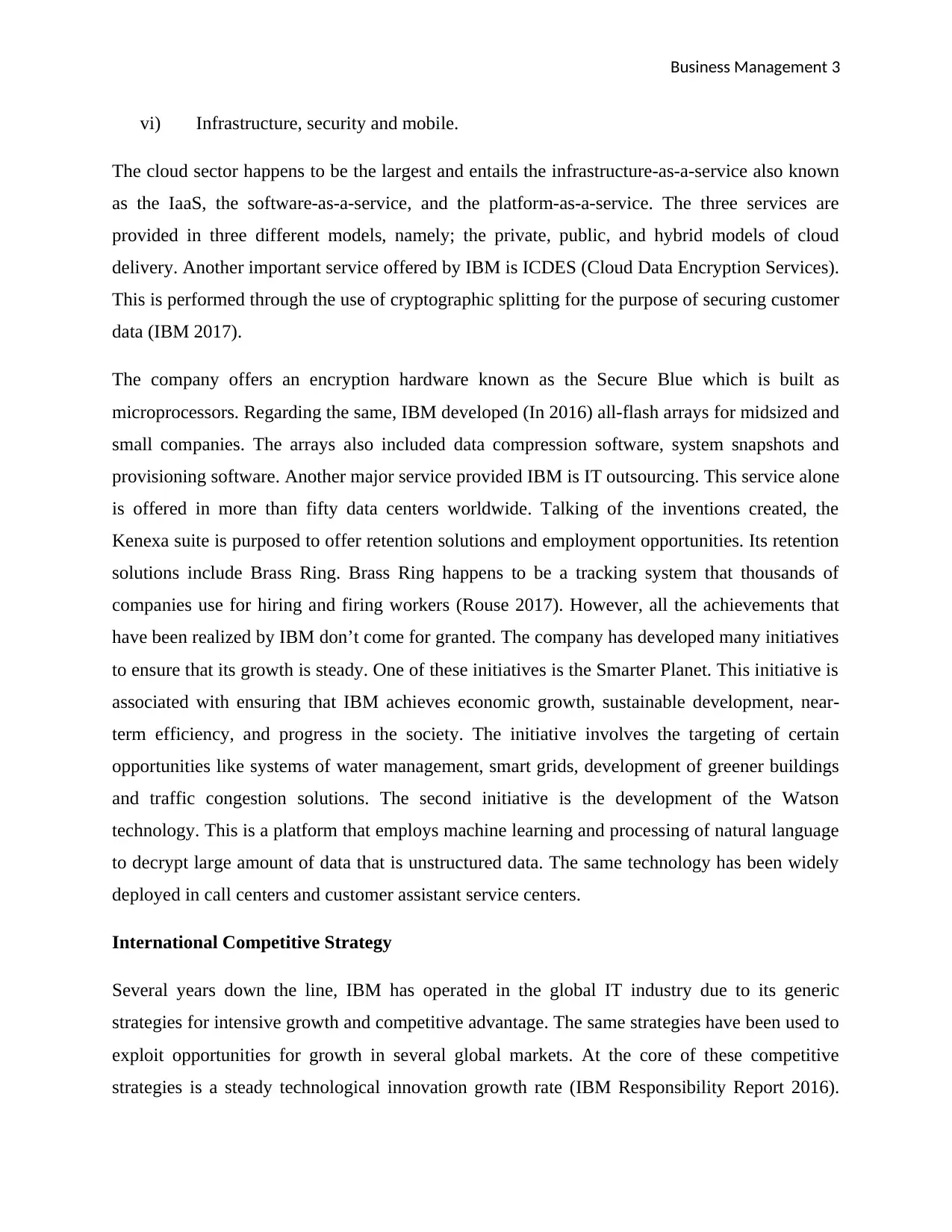
Business Management 3
vi) Infrastructure, security and mobile.
The cloud sector happens to be the largest and entails the infrastructure-as-a-service also known
as the IaaS, the software-as-a-service, and the platform-as-a-service. The three services are
provided in three different models, namely; the private, public, and hybrid models of cloud
delivery. Another important service offered by IBM is ICDES (Cloud Data Encryption Services).
This is performed through the use of cryptographic splitting for the purpose of securing customer
data (IBM 2017).
The company offers an encryption hardware known as the Secure Blue which is built as
microprocessors. Regarding the same, IBM developed (In 2016) all-flash arrays for midsized and
small companies. The arrays also included data compression software, system snapshots and
provisioning software. Another major service provided IBM is IT outsourcing. This service alone
is offered in more than fifty data centers worldwide. Talking of the inventions created, the
Kenexa suite is purposed to offer retention solutions and employment opportunities. Its retention
solutions include Brass Ring. Brass Ring happens to be a tracking system that thousands of
companies use for hiring and firing workers (Rouse 2017). However, all the achievements that
have been realized by IBM don’t come for granted. The company has developed many initiatives
to ensure that its growth is steady. One of these initiatives is the Smarter Planet. This initiative is
associated with ensuring that IBM achieves economic growth, sustainable development, near-
term efficiency, and progress in the society. The initiative involves the targeting of certain
opportunities like systems of water management, smart grids, development of greener buildings
and traffic congestion solutions. The second initiative is the development of the Watson
technology. This is a platform that employs machine learning and processing of natural language
to decrypt large amount of data that is unstructured data. The same technology has been widely
deployed in call centers and customer assistant service centers.
International Competitive Strategy
Several years down the line, IBM has operated in the global IT industry due to its generic
strategies for intensive growth and competitive advantage. The same strategies have been used to
exploit opportunities for growth in several global markets. At the core of these competitive
strategies is a steady technological innovation growth rate (IBM Responsibility Report 2016).
vi) Infrastructure, security and mobile.
The cloud sector happens to be the largest and entails the infrastructure-as-a-service also known
as the IaaS, the software-as-a-service, and the platform-as-a-service. The three services are
provided in three different models, namely; the private, public, and hybrid models of cloud
delivery. Another important service offered by IBM is ICDES (Cloud Data Encryption Services).
This is performed through the use of cryptographic splitting for the purpose of securing customer
data (IBM 2017).
The company offers an encryption hardware known as the Secure Blue which is built as
microprocessors. Regarding the same, IBM developed (In 2016) all-flash arrays for midsized and
small companies. The arrays also included data compression software, system snapshots and
provisioning software. Another major service provided IBM is IT outsourcing. This service alone
is offered in more than fifty data centers worldwide. Talking of the inventions created, the
Kenexa suite is purposed to offer retention solutions and employment opportunities. Its retention
solutions include Brass Ring. Brass Ring happens to be a tracking system that thousands of
companies use for hiring and firing workers (Rouse 2017). However, all the achievements that
have been realized by IBM don’t come for granted. The company has developed many initiatives
to ensure that its growth is steady. One of these initiatives is the Smarter Planet. This initiative is
associated with ensuring that IBM achieves economic growth, sustainable development, near-
term efficiency, and progress in the society. The initiative involves the targeting of certain
opportunities like systems of water management, smart grids, development of greener buildings
and traffic congestion solutions. The second initiative is the development of the Watson
technology. This is a platform that employs machine learning and processing of natural language
to decrypt large amount of data that is unstructured data. The same technology has been widely
deployed in call centers and customer assistant service centers.
International Competitive Strategy
Several years down the line, IBM has operated in the global IT industry due to its generic
strategies for intensive growth and competitive advantage. The same strategies have been used to
exploit opportunities for growth in several global markets. At the core of these competitive
strategies is a steady technological innovation growth rate (IBM Responsibility Report 2016).
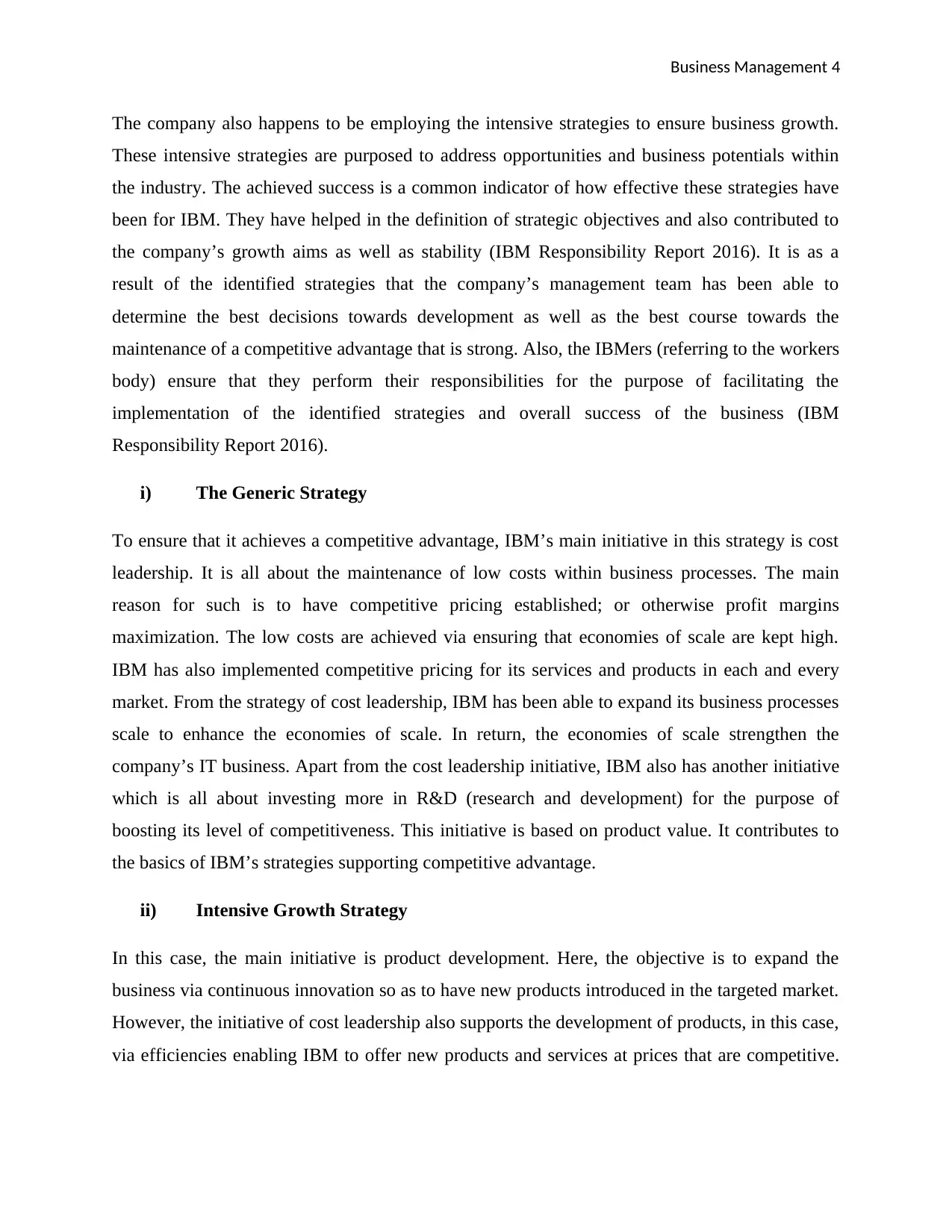
Business Management 4
The company also happens to be employing the intensive strategies to ensure business growth.
These intensive strategies are purposed to address opportunities and business potentials within
the industry. The achieved success is a common indicator of how effective these strategies have
been for IBM. They have helped in the definition of strategic objectives and also contributed to
the company’s growth aims as well as stability (IBM Responsibility Report 2016). It is as a
result of the identified strategies that the company’s management team has been able to
determine the best decisions towards development as well as the best course towards the
maintenance of a competitive advantage that is strong. Also, the IBMers (referring to the workers
body) ensure that they perform their responsibilities for the purpose of facilitating the
implementation of the identified strategies and overall success of the business (IBM
Responsibility Report 2016).
i) The Generic Strategy
To ensure that it achieves a competitive advantage, IBM’s main initiative in this strategy is cost
leadership. It is all about the maintenance of low costs within business processes. The main
reason for such is to have competitive pricing established; or otherwise profit margins
maximization. The low costs are achieved via ensuring that economies of scale are kept high.
IBM has also implemented competitive pricing for its services and products in each and every
market. From the strategy of cost leadership, IBM has been able to expand its business processes
scale to enhance the economies of scale. In return, the economies of scale strengthen the
company’s IT business. Apart from the cost leadership initiative, IBM also has another initiative
which is all about investing more in R&D (research and development) for the purpose of
boosting its level of competitiveness. This initiative is based on product value. It contributes to
the basics of IBM’s strategies supporting competitive advantage.
ii) Intensive Growth Strategy
In this case, the main initiative is product development. Here, the objective is to expand the
business via continuous innovation so as to have new products introduced in the targeted market.
However, the initiative of cost leadership also supports the development of products, in this case,
via efficiencies enabling IBM to offer new products and services at prices that are competitive.
The company also happens to be employing the intensive strategies to ensure business growth.
These intensive strategies are purposed to address opportunities and business potentials within
the industry. The achieved success is a common indicator of how effective these strategies have
been for IBM. They have helped in the definition of strategic objectives and also contributed to
the company’s growth aims as well as stability (IBM Responsibility Report 2016). It is as a
result of the identified strategies that the company’s management team has been able to
determine the best decisions towards development as well as the best course towards the
maintenance of a competitive advantage that is strong. Also, the IBMers (referring to the workers
body) ensure that they perform their responsibilities for the purpose of facilitating the
implementation of the identified strategies and overall success of the business (IBM
Responsibility Report 2016).
i) The Generic Strategy
To ensure that it achieves a competitive advantage, IBM’s main initiative in this strategy is cost
leadership. It is all about the maintenance of low costs within business processes. The main
reason for such is to have competitive pricing established; or otherwise profit margins
maximization. The low costs are achieved via ensuring that economies of scale are kept high.
IBM has also implemented competitive pricing for its services and products in each and every
market. From the strategy of cost leadership, IBM has been able to expand its business processes
scale to enhance the economies of scale. In return, the economies of scale strengthen the
company’s IT business. Apart from the cost leadership initiative, IBM also has another initiative
which is all about investing more in R&D (research and development) for the purpose of
boosting its level of competitiveness. This initiative is based on product value. It contributes to
the basics of IBM’s strategies supporting competitive advantage.
ii) Intensive Growth Strategy
In this case, the main initiative is product development. Here, the objective is to expand the
business via continuous innovation so as to have new products introduced in the targeted market.
However, the initiative of cost leadership also supports the development of products, in this case,
via efficiencies enabling IBM to offer new products and services at prices that are competitive.
Secure Best Marks with AI Grader
Need help grading? Try our AI Grader for instant feedback on your assignments.
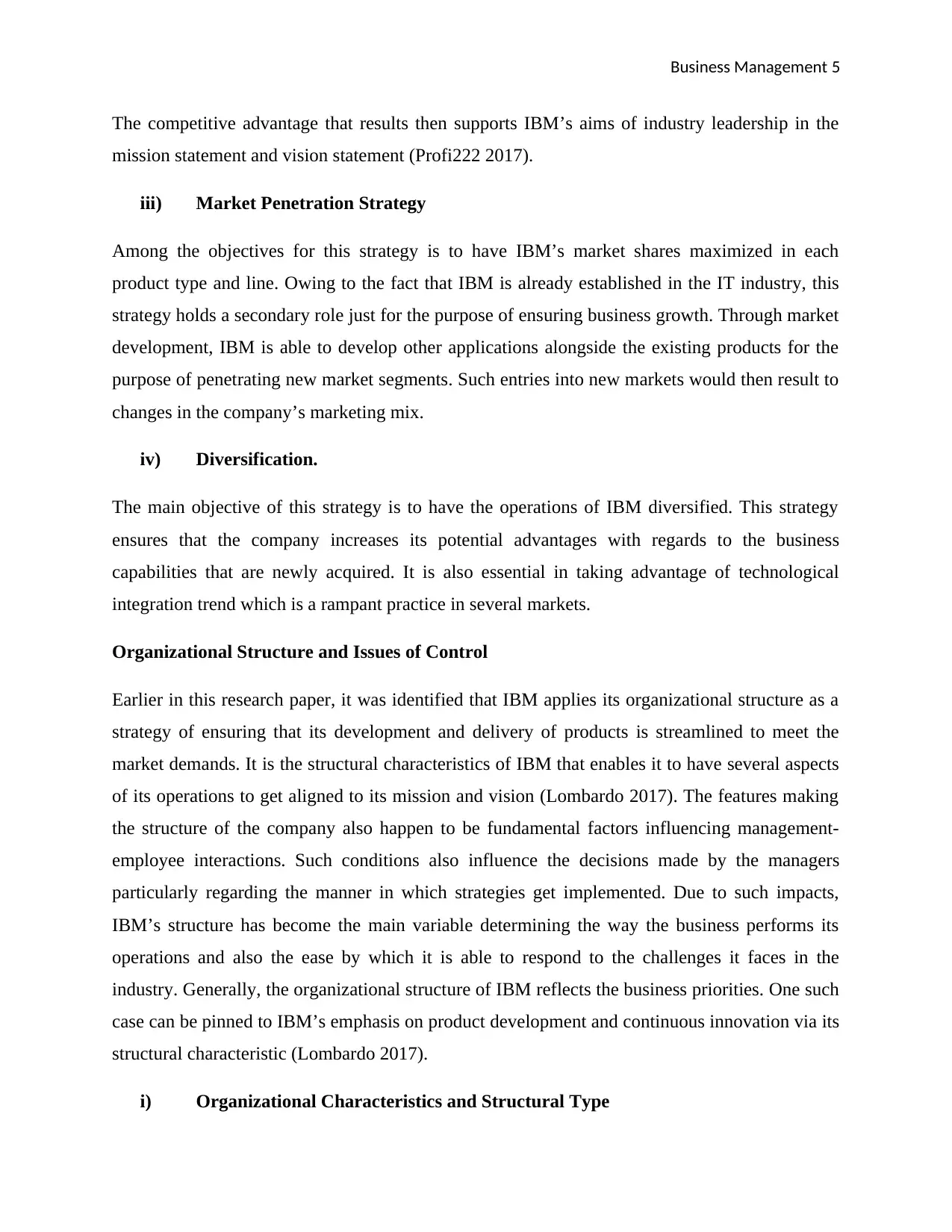
Business Management 5
The competitive advantage that results then supports IBM’s aims of industry leadership in the
mission statement and vision statement (Profi222 2017).
iii) Market Penetration Strategy
Among the objectives for this strategy is to have IBM’s market shares maximized in each
product type and line. Owing to the fact that IBM is already established in the IT industry, this
strategy holds a secondary role just for the purpose of ensuring business growth. Through market
development, IBM is able to develop other applications alongside the existing products for the
purpose of penetrating new market segments. Such entries into new markets would then result to
changes in the company’s marketing mix.
iv) Diversification.
The main objective of this strategy is to have the operations of IBM diversified. This strategy
ensures that the company increases its potential advantages with regards to the business
capabilities that are newly acquired. It is also essential in taking advantage of technological
integration trend which is a rampant practice in several markets.
Organizational Structure and Issues of Control
Earlier in this research paper, it was identified that IBM applies its organizational structure as a
strategy of ensuring that its development and delivery of products is streamlined to meet the
market demands. It is the structural characteristics of IBM that enables it to have several aspects
of its operations to get aligned to its mission and vision (Lombardo 2017). The features making
the structure of the company also happen to be fundamental factors influencing management-
employee interactions. Such conditions also influence the decisions made by the managers
particularly regarding the manner in which strategies get implemented. Due to such impacts,
IBM’s structure has become the main variable determining the way the business performs its
operations and also the ease by which it is able to respond to the challenges it faces in the
industry. Generally, the organizational structure of IBM reflects the business priorities. One such
case can be pinned to IBM’s emphasis on product development and continuous innovation via its
structural characteristic (Lombardo 2017).
i) Organizational Characteristics and Structural Type
The competitive advantage that results then supports IBM’s aims of industry leadership in the
mission statement and vision statement (Profi222 2017).
iii) Market Penetration Strategy
Among the objectives for this strategy is to have IBM’s market shares maximized in each
product type and line. Owing to the fact that IBM is already established in the IT industry, this
strategy holds a secondary role just for the purpose of ensuring business growth. Through market
development, IBM is able to develop other applications alongside the existing products for the
purpose of penetrating new market segments. Such entries into new markets would then result to
changes in the company’s marketing mix.
iv) Diversification.
The main objective of this strategy is to have the operations of IBM diversified. This strategy
ensures that the company increases its potential advantages with regards to the business
capabilities that are newly acquired. It is also essential in taking advantage of technological
integration trend which is a rampant practice in several markets.
Organizational Structure and Issues of Control
Earlier in this research paper, it was identified that IBM applies its organizational structure as a
strategy of ensuring that its development and delivery of products is streamlined to meet the
market demands. It is the structural characteristics of IBM that enables it to have several aspects
of its operations to get aligned to its mission and vision (Lombardo 2017). The features making
the structure of the company also happen to be fundamental factors influencing management-
employee interactions. Such conditions also influence the decisions made by the managers
particularly regarding the manner in which strategies get implemented. Due to such impacts,
IBM’s structure has become the main variable determining the way the business performs its
operations and also the ease by which it is able to respond to the challenges it faces in the
industry. Generally, the organizational structure of IBM reflects the business priorities. One such
case can be pinned to IBM’s emphasis on product development and continuous innovation via its
structural characteristic (Lombardo 2017).
i) Organizational Characteristics and Structural Type
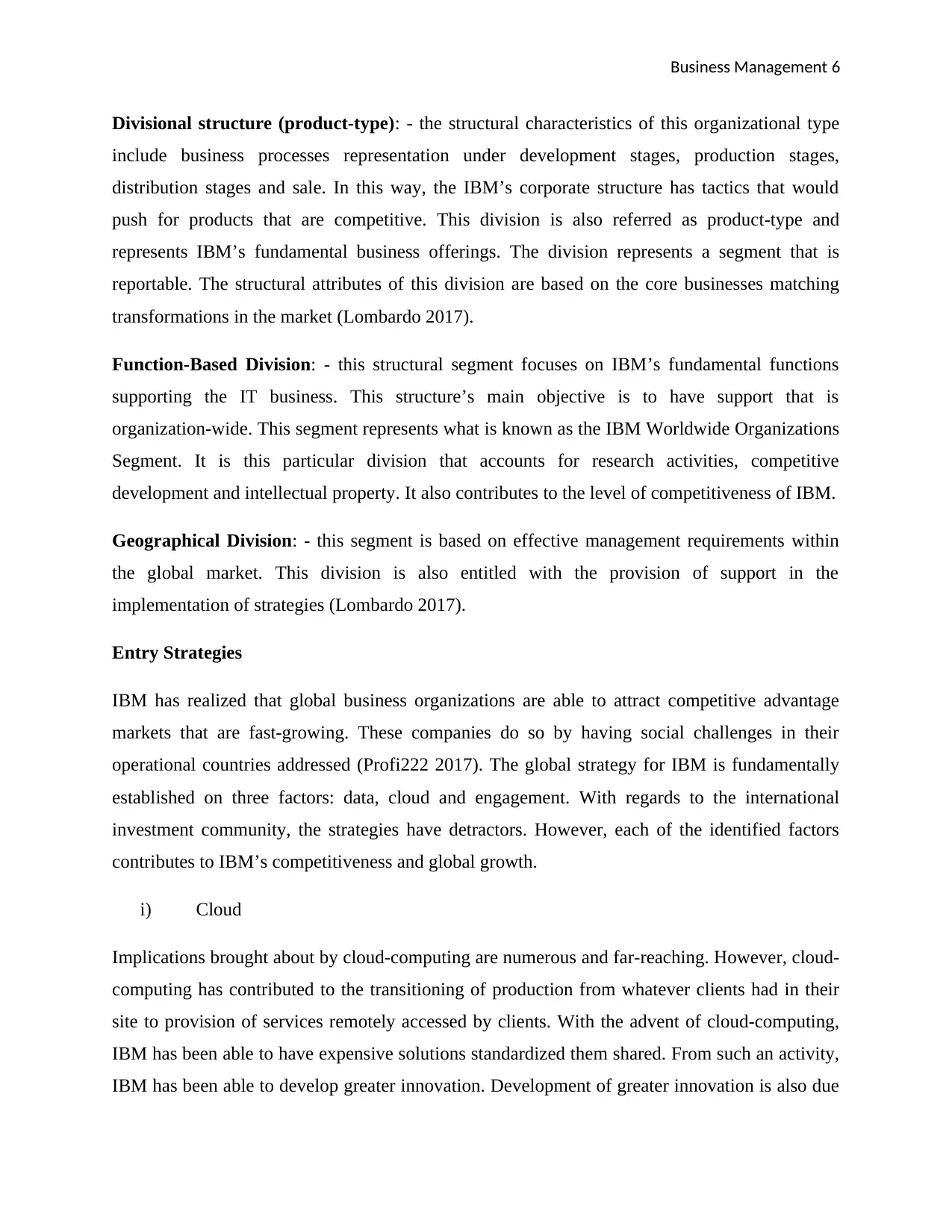
Business Management 6
Divisional structure (product-type): - the structural characteristics of this organizational type
include business processes representation under development stages, production stages,
distribution stages and sale. In this way, the IBM’s corporate structure has tactics that would
push for products that are competitive. This division is also referred as product-type and
represents IBM’s fundamental business offerings. The division represents a segment that is
reportable. The structural attributes of this division are based on the core businesses matching
transformations in the market (Lombardo 2017).
Function-Based Division: - this structural segment focuses on IBM’s fundamental functions
supporting the IT business. This structure’s main objective is to have support that is
organization-wide. This segment represents what is known as the IBM Worldwide Organizations
Segment. It is this particular division that accounts for research activities, competitive
development and intellectual property. It also contributes to the level of competitiveness of IBM.
Geographical Division: - this segment is based on effective management requirements within
the global market. This division is also entitled with the provision of support in the
implementation of strategies (Lombardo 2017).
Entry Strategies
IBM has realized that global business organizations are able to attract competitive advantage
markets that are fast-growing. These companies do so by having social challenges in their
operational countries addressed (Profi222 2017). The global strategy for IBM is fundamentally
established on three factors: data, cloud and engagement. With regards to the international
investment community, the strategies have detractors. However, each of the identified factors
contributes to IBM’s competitiveness and global growth.
i) Cloud
Implications brought about by cloud-computing are numerous and far-reaching. However, cloud-
computing has contributed to the transitioning of production from whatever clients had in their
site to provision of services remotely accessed by clients. With the advent of cloud-computing,
IBM has been able to have expensive solutions standardized them shared. From such an activity,
IBM has been able to develop greater innovation. Development of greater innovation is also due
Divisional structure (product-type): - the structural characteristics of this organizational type
include business processes representation under development stages, production stages,
distribution stages and sale. In this way, the IBM’s corporate structure has tactics that would
push for products that are competitive. This division is also referred as product-type and
represents IBM’s fundamental business offerings. The division represents a segment that is
reportable. The structural attributes of this division are based on the core businesses matching
transformations in the market (Lombardo 2017).
Function-Based Division: - this structural segment focuses on IBM’s fundamental functions
supporting the IT business. This structure’s main objective is to have support that is
organization-wide. This segment represents what is known as the IBM Worldwide Organizations
Segment. It is this particular division that accounts for research activities, competitive
development and intellectual property. It also contributes to the level of competitiveness of IBM.
Geographical Division: - this segment is based on effective management requirements within
the global market. This division is also entitled with the provision of support in the
implementation of strategies (Lombardo 2017).
Entry Strategies
IBM has realized that global business organizations are able to attract competitive advantage
markets that are fast-growing. These companies do so by having social challenges in their
operational countries addressed (Profi222 2017). The global strategy for IBM is fundamentally
established on three factors: data, cloud and engagement. With regards to the international
investment community, the strategies have detractors. However, each of the identified factors
contributes to IBM’s competitiveness and global growth.
i) Cloud
Implications brought about by cloud-computing are numerous and far-reaching. However, cloud-
computing has contributed to the transitioning of production from whatever clients had in their
site to provision of services remotely accessed by clients. With the advent of cloud-computing,
IBM has been able to have expensive solutions standardized them shared. From such an activity,
IBM has been able to develop greater innovation. Development of greater innovation is also due
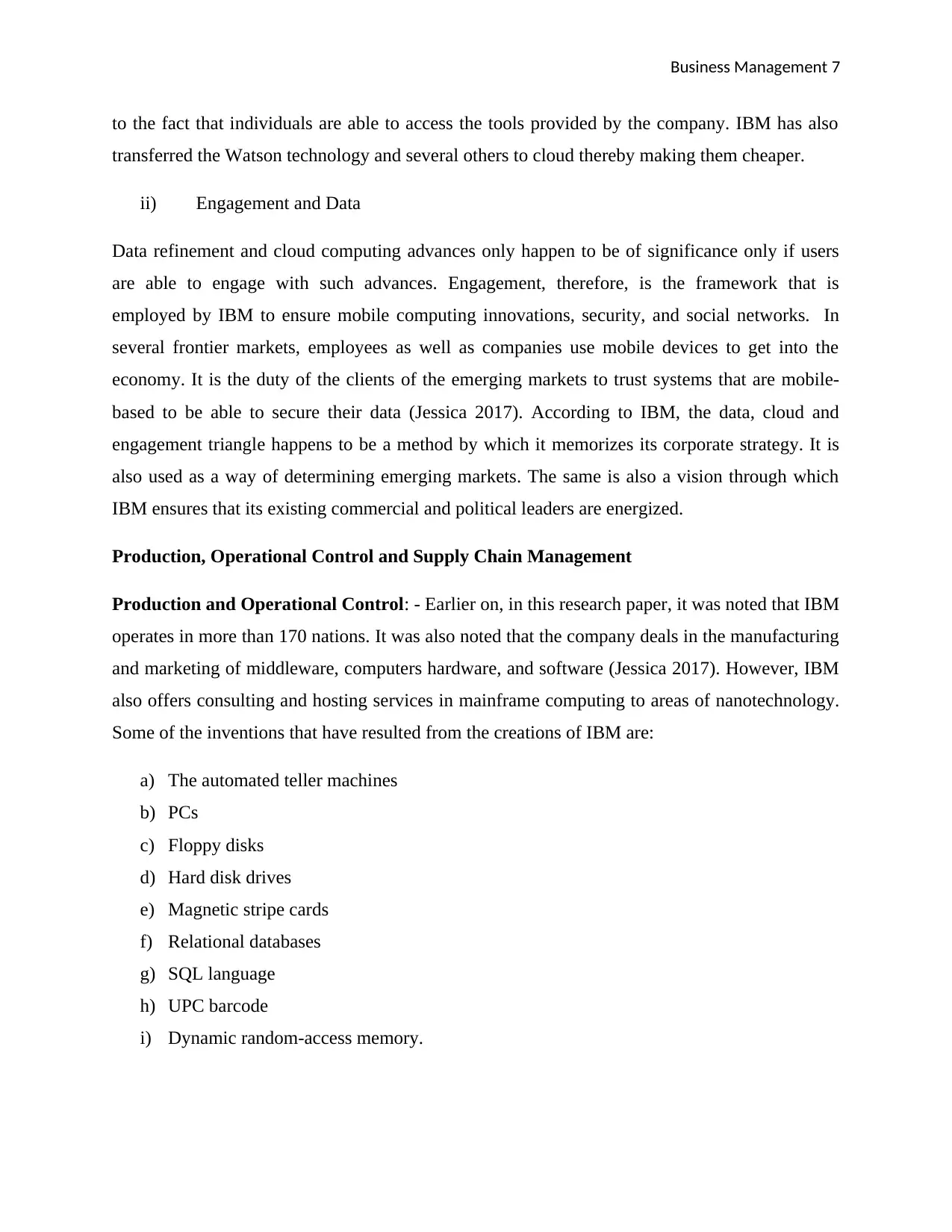
Business Management 7
to the fact that individuals are able to access the tools provided by the company. IBM has also
transferred the Watson technology and several others to cloud thereby making them cheaper.
ii) Engagement and Data
Data refinement and cloud computing advances only happen to be of significance only if users
are able to engage with such advances. Engagement, therefore, is the framework that is
employed by IBM to ensure mobile computing innovations, security, and social networks. In
several frontier markets, employees as well as companies use mobile devices to get into the
economy. It is the duty of the clients of the emerging markets to trust systems that are mobile-
based to be able to secure their data (Jessica 2017). According to IBM, the data, cloud and
engagement triangle happens to be a method by which it memorizes its corporate strategy. It is
also used as a way of determining emerging markets. The same is also a vision through which
IBM ensures that its existing commercial and political leaders are energized.
Production, Operational Control and Supply Chain Management
Production and Operational Control: - Earlier on, in this research paper, it was noted that IBM
operates in more than 170 nations. It was also noted that the company deals in the manufacturing
and marketing of middleware, computers hardware, and software (Jessica 2017). However, IBM
also offers consulting and hosting services in mainframe computing to areas of nanotechnology.
Some of the inventions that have resulted from the creations of IBM are:
a) The automated teller machines
b) PCs
c) Floppy disks
d) Hard disk drives
e) Magnetic stripe cards
f) Relational databases
g) SQL language
h) UPC barcode
i) Dynamic random-access memory.
to the fact that individuals are able to access the tools provided by the company. IBM has also
transferred the Watson technology and several others to cloud thereby making them cheaper.
ii) Engagement and Data
Data refinement and cloud computing advances only happen to be of significance only if users
are able to engage with such advances. Engagement, therefore, is the framework that is
employed by IBM to ensure mobile computing innovations, security, and social networks. In
several frontier markets, employees as well as companies use mobile devices to get into the
economy. It is the duty of the clients of the emerging markets to trust systems that are mobile-
based to be able to secure their data (Jessica 2017). According to IBM, the data, cloud and
engagement triangle happens to be a method by which it memorizes its corporate strategy. It is
also used as a way of determining emerging markets. The same is also a vision through which
IBM ensures that its existing commercial and political leaders are energized.
Production, Operational Control and Supply Chain Management
Production and Operational Control: - Earlier on, in this research paper, it was noted that IBM
operates in more than 170 nations. It was also noted that the company deals in the manufacturing
and marketing of middleware, computers hardware, and software (Jessica 2017). However, IBM
also offers consulting and hosting services in mainframe computing to areas of nanotechnology.
Some of the inventions that have resulted from the creations of IBM are:
a) The automated teller machines
b) PCs
c) Floppy disks
d) Hard disk drives
e) Magnetic stripe cards
f) Relational databases
g) SQL language
h) UPC barcode
i) Dynamic random-access memory.
Paraphrase This Document
Need a fresh take? Get an instant paraphrase of this document with our AI Paraphraser
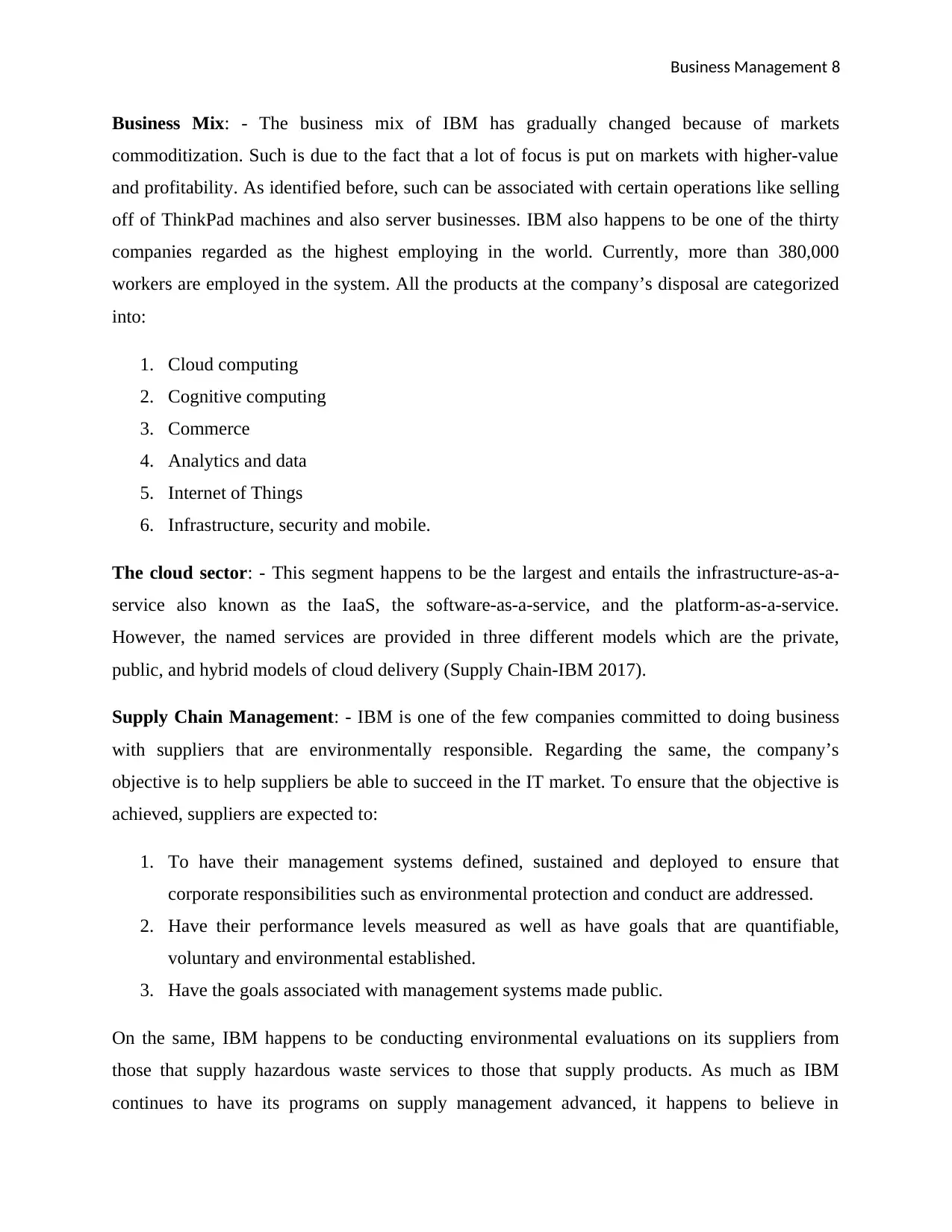
Business Management 8
Business Mix: - The business mix of IBM has gradually changed because of markets
commoditization. Such is due to the fact that a lot of focus is put on markets with higher-value
and profitability. As identified before, such can be associated with certain operations like selling
off of ThinkPad machines and also server businesses. IBM also happens to be one of the thirty
companies regarded as the highest employing in the world. Currently, more than 380,000
workers are employed in the system. All the products at the company’s disposal are categorized
into:
1. Cloud computing
2. Cognitive computing
3. Commerce
4. Analytics and data
5. Internet of Things
6. Infrastructure, security and mobile.
The cloud sector: - This segment happens to be the largest and entails the infrastructure-as-a-
service also known as the IaaS, the software-as-a-service, and the platform-as-a-service.
However, the named services are provided in three different models which are the private,
public, and hybrid models of cloud delivery (Supply Chain-IBM 2017).
Supply Chain Management: - IBM is one of the few companies committed to doing business
with suppliers that are environmentally responsible. Regarding the same, the company’s
objective is to help suppliers be able to succeed in the IT market. To ensure that the objective is
achieved, suppliers are expected to:
1. To have their management systems defined, sustained and deployed to ensure that
corporate responsibilities such as environmental protection and conduct are addressed.
2. Have their performance levels measured as well as have goals that are quantifiable,
voluntary and environmental established.
3. Have the goals associated with management systems made public.
On the same, IBM happens to be conducting environmental evaluations on its suppliers from
those that supply hazardous waste services to those that supply products. As much as IBM
continues to have its programs on supply management advanced, it happens to believe in
Business Mix: - The business mix of IBM has gradually changed because of markets
commoditization. Such is due to the fact that a lot of focus is put on markets with higher-value
and profitability. As identified before, such can be associated with certain operations like selling
off of ThinkPad machines and also server businesses. IBM also happens to be one of the thirty
companies regarded as the highest employing in the world. Currently, more than 380,000
workers are employed in the system. All the products at the company’s disposal are categorized
into:
1. Cloud computing
2. Cognitive computing
3. Commerce
4. Analytics and data
5. Internet of Things
6. Infrastructure, security and mobile.
The cloud sector: - This segment happens to be the largest and entails the infrastructure-as-a-
service also known as the IaaS, the software-as-a-service, and the platform-as-a-service.
However, the named services are provided in three different models which are the private,
public, and hybrid models of cloud delivery (Supply Chain-IBM 2017).
Supply Chain Management: - IBM is one of the few companies committed to doing business
with suppliers that are environmentally responsible. Regarding the same, the company’s
objective is to help suppliers be able to succeed in the IT market. To ensure that the objective is
achieved, suppliers are expected to:
1. To have their management systems defined, sustained and deployed to ensure that
corporate responsibilities such as environmental protection and conduct are addressed.
2. Have their performance levels measured as well as have goals that are quantifiable,
voluntary and environmental established.
3. Have the goals associated with management systems made public.
On the same, IBM happens to be conducting environmental evaluations on its suppliers from
those that supply hazardous waste services to those that supply products. As much as IBM
continues to have its programs on supply management advanced, it happens to believe in
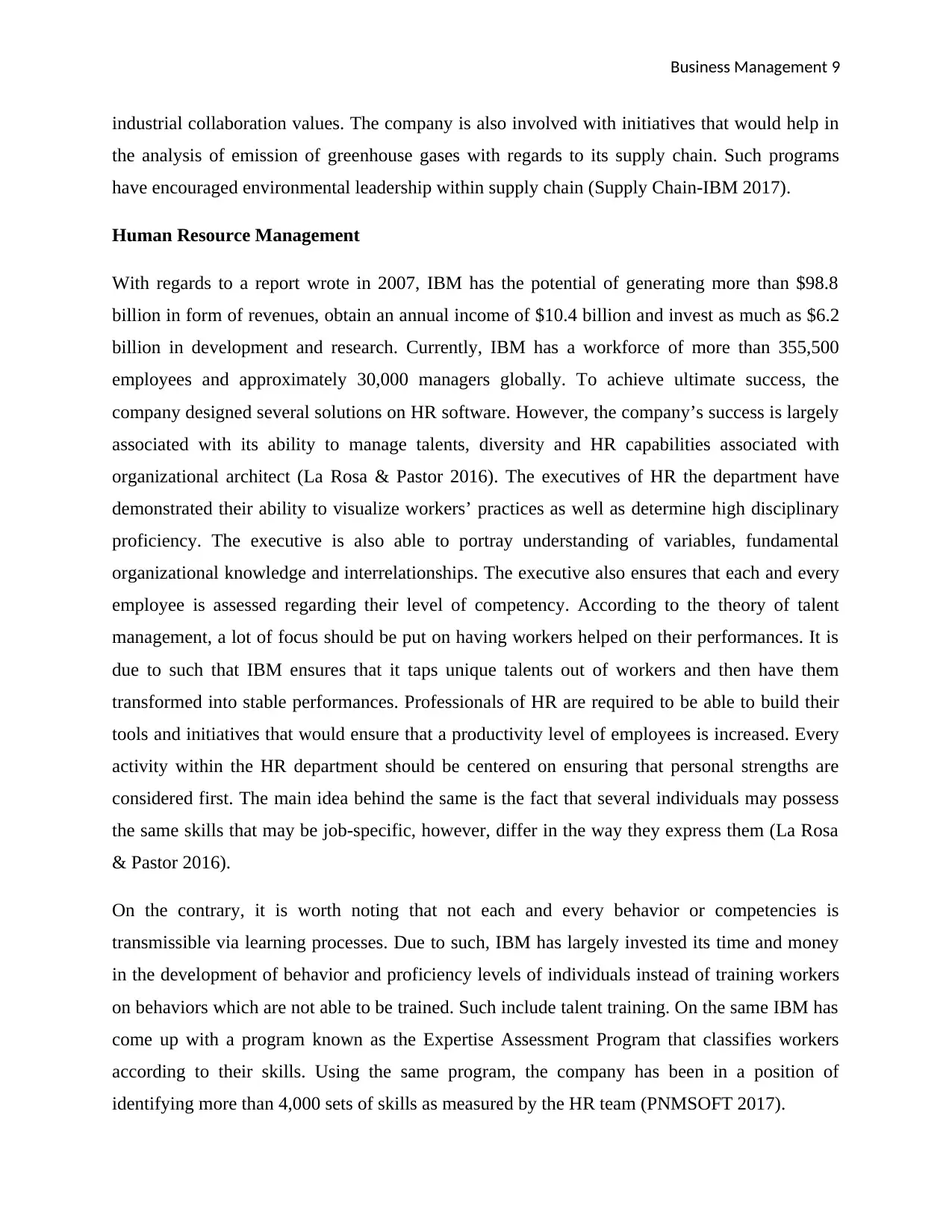
Business Management 9
industrial collaboration values. The company is also involved with initiatives that would help in
the analysis of emission of greenhouse gases with regards to its supply chain. Such programs
have encouraged environmental leadership within supply chain (Supply Chain-IBM 2017).
Human Resource Management
With regards to a report wrote in 2007, IBM has the potential of generating more than $98.8
billion in form of revenues, obtain an annual income of $10.4 billion and invest as much as $6.2
billion in development and research. Currently, IBM has a workforce of more than 355,500
employees and approximately 30,000 managers globally. To achieve ultimate success, the
company designed several solutions on HR software. However, the company’s success is largely
associated with its ability to manage talents, diversity and HR capabilities associated with
organizational architect (La Rosa & Pastor 2016). The executives of HR the department have
demonstrated their ability to visualize workers’ practices as well as determine high disciplinary
proficiency. The executive is also able to portray understanding of variables, fundamental
organizational knowledge and interrelationships. The executive also ensures that each and every
employee is assessed regarding their level of competency. According to the theory of talent
management, a lot of focus should be put on having workers helped on their performances. It is
due to such that IBM ensures that it taps unique talents out of workers and then have them
transformed into stable performances. Professionals of HR are required to be able to build their
tools and initiatives that would ensure that a productivity level of employees is increased. Every
activity within the HR department should be centered on ensuring that personal strengths are
considered first. The main idea behind the same is the fact that several individuals may possess
the same skills that may be job-specific, however, differ in the way they express them (La Rosa
& Pastor 2016).
On the contrary, it is worth noting that not each and every behavior or competencies is
transmissible via learning processes. Due to such, IBM has largely invested its time and money
in the development of behavior and proficiency levels of individuals instead of training workers
on behaviors which are not able to be trained. Such include talent training. On the same IBM has
come up with a program known as the Expertise Assessment Program that classifies workers
according to their skills. Using the same program, the company has been in a position of
identifying more than 4,000 sets of skills as measured by the HR team (PNMSOFT 2017).
industrial collaboration values. The company is also involved with initiatives that would help in
the analysis of emission of greenhouse gases with regards to its supply chain. Such programs
have encouraged environmental leadership within supply chain (Supply Chain-IBM 2017).
Human Resource Management
With regards to a report wrote in 2007, IBM has the potential of generating more than $98.8
billion in form of revenues, obtain an annual income of $10.4 billion and invest as much as $6.2
billion in development and research. Currently, IBM has a workforce of more than 355,500
employees and approximately 30,000 managers globally. To achieve ultimate success, the
company designed several solutions on HR software. However, the company’s success is largely
associated with its ability to manage talents, diversity and HR capabilities associated with
organizational architect (La Rosa & Pastor 2016). The executives of HR the department have
demonstrated their ability to visualize workers’ practices as well as determine high disciplinary
proficiency. The executive is also able to portray understanding of variables, fundamental
organizational knowledge and interrelationships. The executive also ensures that each and every
employee is assessed regarding their level of competency. According to the theory of talent
management, a lot of focus should be put on having workers helped on their performances. It is
due to such that IBM ensures that it taps unique talents out of workers and then have them
transformed into stable performances. Professionals of HR are required to be able to build their
tools and initiatives that would ensure that a productivity level of employees is increased. Every
activity within the HR department should be centered on ensuring that personal strengths are
considered first. The main idea behind the same is the fact that several individuals may possess
the same skills that may be job-specific, however, differ in the way they express them (La Rosa
& Pastor 2016).
On the contrary, it is worth noting that not each and every behavior or competencies is
transmissible via learning processes. Due to such, IBM has largely invested its time and money
in the development of behavior and proficiency levels of individuals instead of training workers
on behaviors which are not able to be trained. Such include talent training. On the same IBM has
come up with a program known as the Expertise Assessment Program that classifies workers
according to their skills. Using the same program, the company has been in a position of
identifying more than 4,000 sets of skills as measured by the HR team (PNMSOFT 2017).
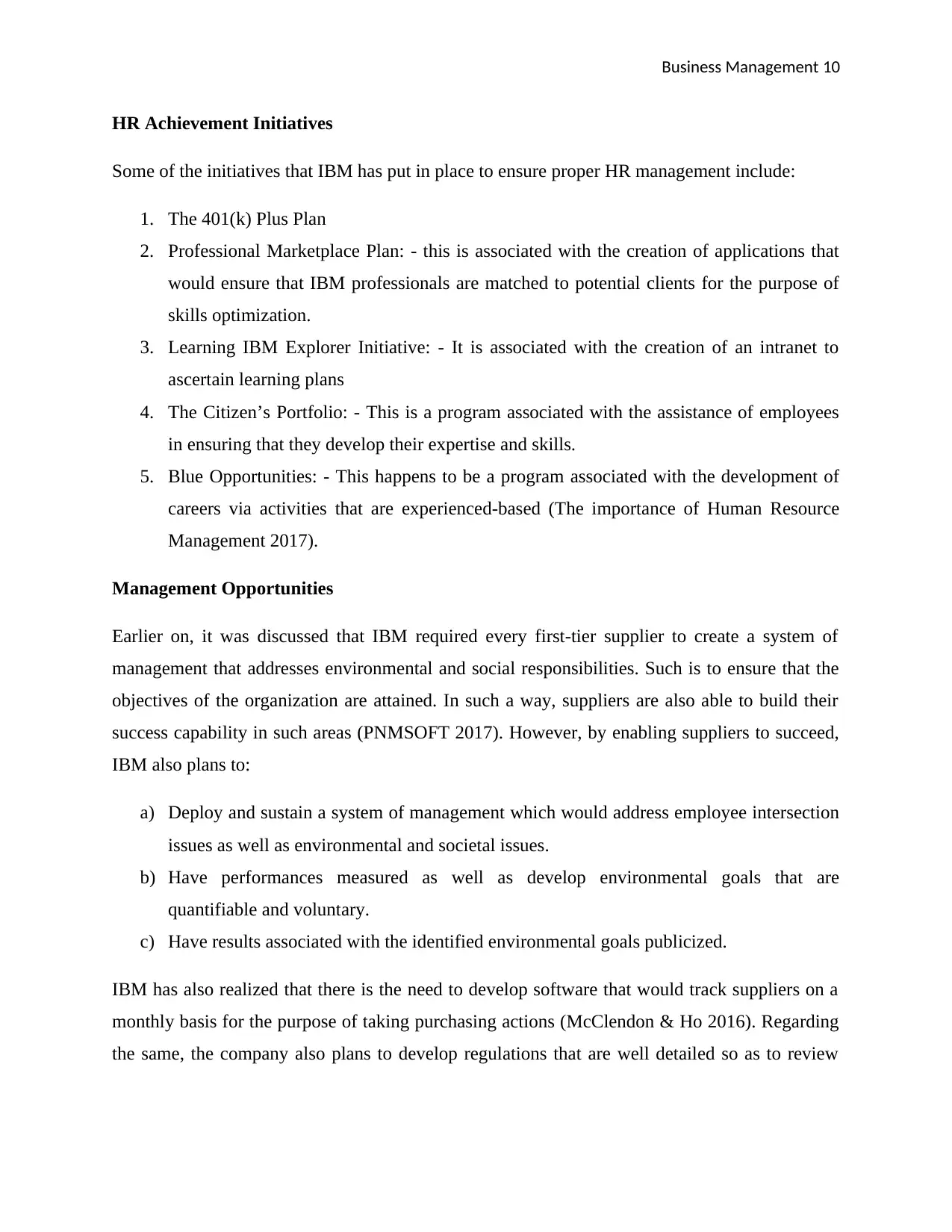
Business Management 10
HR Achievement Initiatives
Some of the initiatives that IBM has put in place to ensure proper HR management include:
1. The 401(k) Plus Plan
2. Professional Marketplace Plan: - this is associated with the creation of applications that
would ensure that IBM professionals are matched to potential clients for the purpose of
skills optimization.
3. Learning IBM Explorer Initiative: - It is associated with the creation of an intranet to
ascertain learning plans
4. The Citizen’s Portfolio: - This is a program associated with the assistance of employees
in ensuring that they develop their expertise and skills.
5. Blue Opportunities: - This happens to be a program associated with the development of
careers via activities that are experienced-based (The importance of Human Resource
Management 2017).
Management Opportunities
Earlier on, it was discussed that IBM required every first-tier supplier to create a system of
management that addresses environmental and social responsibilities. Such is to ensure that the
objectives of the organization are attained. In such a way, suppliers are also able to build their
success capability in such areas (PNMSOFT 2017). However, by enabling suppliers to succeed,
IBM also plans to:
a) Deploy and sustain a system of management which would address employee intersection
issues as well as environmental and societal issues.
b) Have performances measured as well as develop environmental goals that are
quantifiable and voluntary.
c) Have results associated with the identified environmental goals publicized.
IBM has also realized that there is the need to develop software that would track suppliers on a
monthly basis for the purpose of taking purchasing actions (McClendon & Ho 2016). Regarding
the same, the company also plans to develop regulations that are well detailed so as to review
HR Achievement Initiatives
Some of the initiatives that IBM has put in place to ensure proper HR management include:
1. The 401(k) Plus Plan
2. Professional Marketplace Plan: - this is associated with the creation of applications that
would ensure that IBM professionals are matched to potential clients for the purpose of
skills optimization.
3. Learning IBM Explorer Initiative: - It is associated with the creation of an intranet to
ascertain learning plans
4. The Citizen’s Portfolio: - This is a program associated with the assistance of employees
in ensuring that they develop their expertise and skills.
5. Blue Opportunities: - This happens to be a program associated with the development of
careers via activities that are experienced-based (The importance of Human Resource
Management 2017).
Management Opportunities
Earlier on, it was discussed that IBM required every first-tier supplier to create a system of
management that addresses environmental and social responsibilities. Such is to ensure that the
objectives of the organization are attained. In such a way, suppliers are also able to build their
success capability in such areas (PNMSOFT 2017). However, by enabling suppliers to succeed,
IBM also plans to:
a) Deploy and sustain a system of management which would address employee intersection
issues as well as environmental and societal issues.
b) Have performances measured as well as develop environmental goals that are
quantifiable and voluntary.
c) Have results associated with the identified environmental goals publicized.
IBM has also realized that there is the need to develop software that would track suppliers on a
monthly basis for the purpose of taking purchasing actions (McClendon & Ho 2016). Regarding
the same, the company also plans to develop regulations that are well detailed so as to review
Secure Best Marks with AI Grader
Need help grading? Try our AI Grader for instant feedback on your assignments.
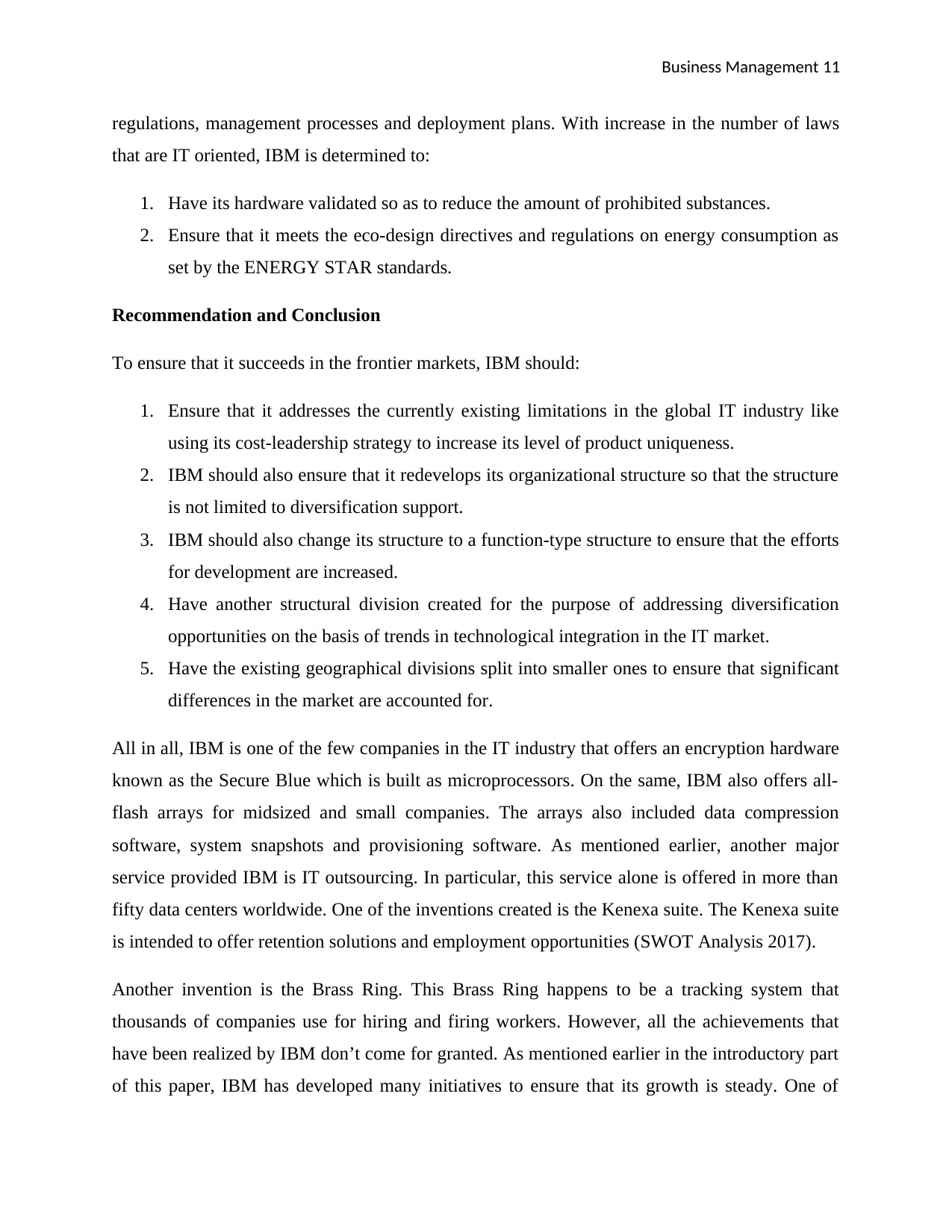
Business Management 11
regulations, management processes and deployment plans. With increase in the number of laws
that are IT oriented, IBM is determined to:
1. Have its hardware validated so as to reduce the amount of prohibited substances.
2. Ensure that it meets the eco-design directives and regulations on energy consumption as
set by the ENERGY STAR standards.
Recommendation and Conclusion
To ensure that it succeeds in the frontier markets, IBM should:
1. Ensure that it addresses the currently existing limitations in the global IT industry like
using its cost-leadership strategy to increase its level of product uniqueness.
2. IBM should also ensure that it redevelops its organizational structure so that the structure
is not limited to diversification support.
3. IBM should also change its structure to a function-type structure to ensure that the efforts
for development are increased.
4. Have another structural division created for the purpose of addressing diversification
opportunities on the basis of trends in technological integration in the IT market.
5. Have the existing geographical divisions split into smaller ones to ensure that significant
differences in the market are accounted for.
All in all, IBM is one of the few companies in the IT industry that offers an encryption hardware
known as the Secure Blue which is built as microprocessors. On the same, IBM also offers all-
flash arrays for midsized and small companies. The arrays also included data compression
software, system snapshots and provisioning software. As mentioned earlier, another major
service provided IBM is IT outsourcing. In particular, this service alone is offered in more than
fifty data centers worldwide. One of the inventions created is the Kenexa suite. The Kenexa suite
is intended to offer retention solutions and employment opportunities (SWOT Analysis 2017).
Another invention is the Brass Ring. This Brass Ring happens to be a tracking system that
thousands of companies use for hiring and firing workers. However, all the achievements that
have been realized by IBM don’t come for granted. As mentioned earlier in the introductory part
of this paper, IBM has developed many initiatives to ensure that its growth is steady. One of
regulations, management processes and deployment plans. With increase in the number of laws
that are IT oriented, IBM is determined to:
1. Have its hardware validated so as to reduce the amount of prohibited substances.
2. Ensure that it meets the eco-design directives and regulations on energy consumption as
set by the ENERGY STAR standards.
Recommendation and Conclusion
To ensure that it succeeds in the frontier markets, IBM should:
1. Ensure that it addresses the currently existing limitations in the global IT industry like
using its cost-leadership strategy to increase its level of product uniqueness.
2. IBM should also ensure that it redevelops its organizational structure so that the structure
is not limited to diversification support.
3. IBM should also change its structure to a function-type structure to ensure that the efforts
for development are increased.
4. Have another structural division created for the purpose of addressing diversification
opportunities on the basis of trends in technological integration in the IT market.
5. Have the existing geographical divisions split into smaller ones to ensure that significant
differences in the market are accounted for.
All in all, IBM is one of the few companies in the IT industry that offers an encryption hardware
known as the Secure Blue which is built as microprocessors. On the same, IBM also offers all-
flash arrays for midsized and small companies. The arrays also included data compression
software, system snapshots and provisioning software. As mentioned earlier, another major
service provided IBM is IT outsourcing. In particular, this service alone is offered in more than
fifty data centers worldwide. One of the inventions created is the Kenexa suite. The Kenexa suite
is intended to offer retention solutions and employment opportunities (SWOT Analysis 2017).
Another invention is the Brass Ring. This Brass Ring happens to be a tracking system that
thousands of companies use for hiring and firing workers. However, all the achievements that
have been realized by IBM don’t come for granted. As mentioned earlier in the introductory part
of this paper, IBM has developed many initiatives to ensure that its growth is steady. One of
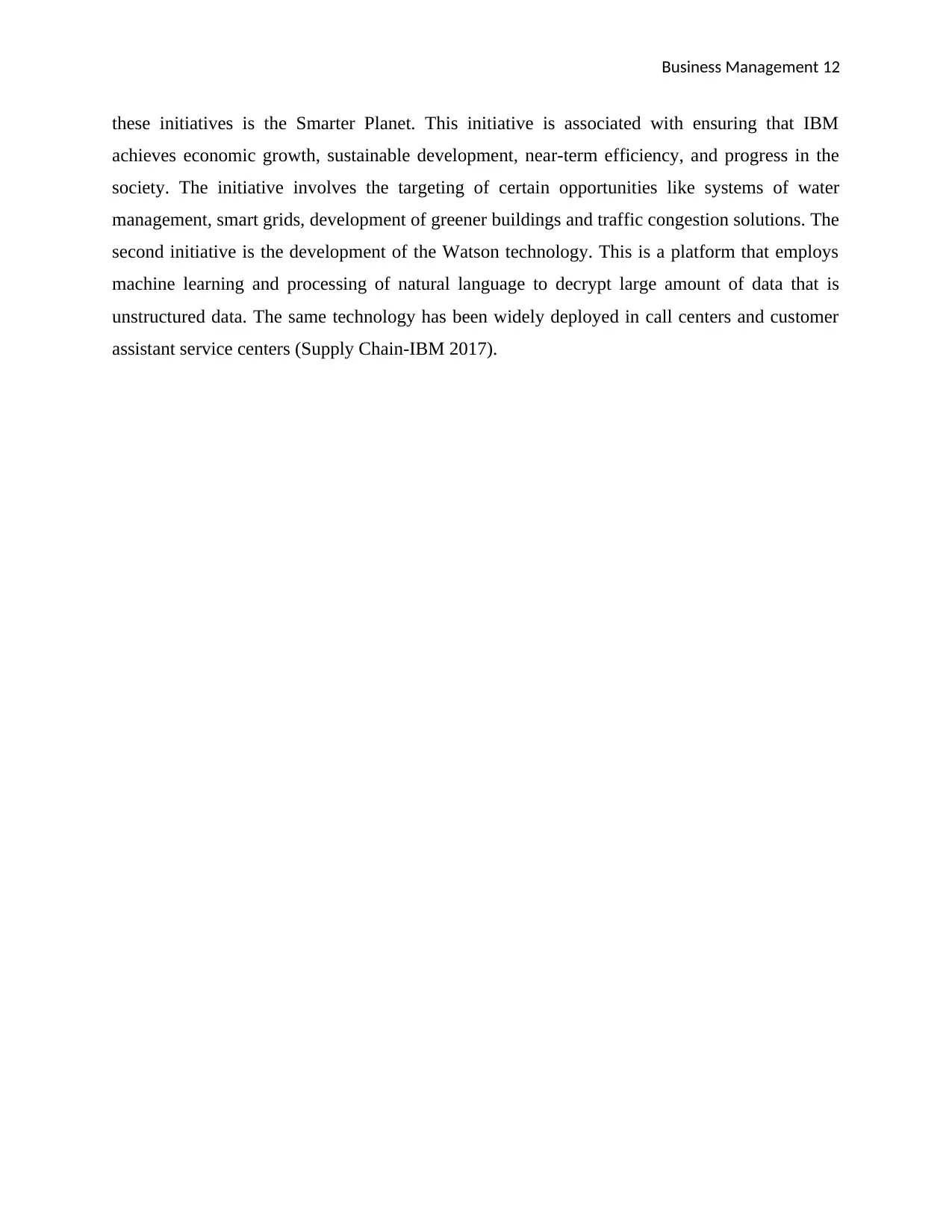
Business Management 12
these initiatives is the Smarter Planet. This initiative is associated with ensuring that IBM
achieves economic growth, sustainable development, near-term efficiency, and progress in the
society. The initiative involves the targeting of certain opportunities like systems of water
management, smart grids, development of greener buildings and traffic congestion solutions. The
second initiative is the development of the Watson technology. This is a platform that employs
machine learning and processing of natural language to decrypt large amount of data that is
unstructured data. The same technology has been widely deployed in call centers and customer
assistant service centers (Supply Chain-IBM 2017).
these initiatives is the Smarter Planet. This initiative is associated with ensuring that IBM
achieves economic growth, sustainable development, near-term efficiency, and progress in the
society. The initiative involves the targeting of certain opportunities like systems of water
management, smart grids, development of greener buildings and traffic congestion solutions. The
second initiative is the development of the Watson technology. This is a platform that employs
machine learning and processing of natural language to decrypt large amount of data that is
unstructured data. The same technology has been widely deployed in call centers and customer
assistant service centers (Supply Chain-IBM 2017).
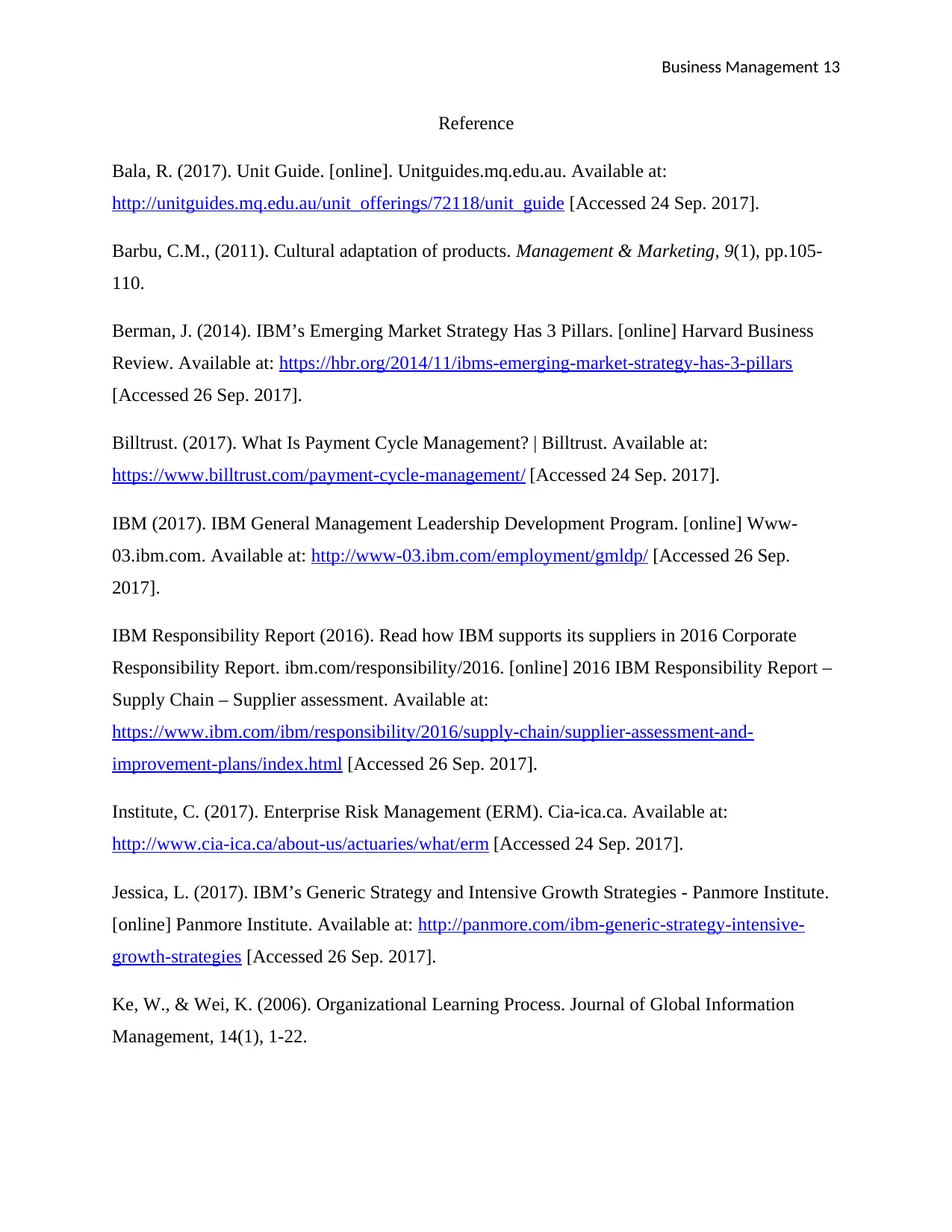
Business Management 13
Reference
Bala, R. (2017). Unit Guide. [online]. Unitguides.mq.edu.au. Available at:
http://unitguides.mq.edu.au/unit_offerings/72118/unit_guide [Accessed 24 Sep. 2017].
Barbu, C.M., (2011). Cultural adaptation of products. Management & Marketing, 9(1), pp.105-
110.
Berman, J. (2014). IBM’s Emerging Market Strategy Has 3 Pillars. [online] Harvard Business
Review. Available at: https://hbr.org/2014/11/ibms-emerging-market-strategy-has-3-pillars
[Accessed 26 Sep. 2017].
Billtrust. (2017). What Is Payment Cycle Management? | Billtrust. Available at:
https://www.billtrust.com/payment-cycle-management/ [Accessed 24 Sep. 2017].
IBM (2017). IBM General Management Leadership Development Program. [online] Www-
03.ibm.com. Available at: http://www-03.ibm.com/employment/gmldp/ [Accessed 26 Sep.
2017].
IBM Responsibility Report (2016). Read how IBM supports its suppliers in 2016 Corporate
Responsibility Report. ibm.com/responsibility/2016. [online] 2016 IBM Responsibility Report –
Supply Chain – Supplier assessment. Available at:
https://www.ibm.com/ibm/responsibility/2016/supply-chain/supplier-assessment-and-
improvement-plans/index.html [Accessed 26 Sep. 2017].
Institute, C. (2017). Enterprise Risk Management (ERM). Cia-ica.ca. Available at:
http://www.cia-ica.ca/about-us/actuaries/what/erm [Accessed 24 Sep. 2017].
Jessica, L. (2017). IBM’s Generic Strategy and Intensive Growth Strategies - Panmore Institute.
[online] Panmore Institute. Available at: http://panmore.com/ibm-generic-strategy-intensive-
growth-strategies [Accessed 26 Sep. 2017].
Ke, W., & Wei, K. (2006). Organizational Learning Process. Journal of Global Information
Management, 14(1), 1-22.
Reference
Bala, R. (2017). Unit Guide. [online]. Unitguides.mq.edu.au. Available at:
http://unitguides.mq.edu.au/unit_offerings/72118/unit_guide [Accessed 24 Sep. 2017].
Barbu, C.M., (2011). Cultural adaptation of products. Management & Marketing, 9(1), pp.105-
110.
Berman, J. (2014). IBM’s Emerging Market Strategy Has 3 Pillars. [online] Harvard Business
Review. Available at: https://hbr.org/2014/11/ibms-emerging-market-strategy-has-3-pillars
[Accessed 26 Sep. 2017].
Billtrust. (2017). What Is Payment Cycle Management? | Billtrust. Available at:
https://www.billtrust.com/payment-cycle-management/ [Accessed 24 Sep. 2017].
IBM (2017). IBM General Management Leadership Development Program. [online] Www-
03.ibm.com. Available at: http://www-03.ibm.com/employment/gmldp/ [Accessed 26 Sep.
2017].
IBM Responsibility Report (2016). Read how IBM supports its suppliers in 2016 Corporate
Responsibility Report. ibm.com/responsibility/2016. [online] 2016 IBM Responsibility Report –
Supply Chain – Supplier assessment. Available at:
https://www.ibm.com/ibm/responsibility/2016/supply-chain/supplier-assessment-and-
improvement-plans/index.html [Accessed 26 Sep. 2017].
Institute, C. (2017). Enterprise Risk Management (ERM). Cia-ica.ca. Available at:
http://www.cia-ica.ca/about-us/actuaries/what/erm [Accessed 24 Sep. 2017].
Jessica, L. (2017). IBM’s Generic Strategy and Intensive Growth Strategies - Panmore Institute.
[online] Panmore Institute. Available at: http://panmore.com/ibm-generic-strategy-intensive-
growth-strategies [Accessed 26 Sep. 2017].
Ke, W., & Wei, K. (2006). Organizational Learning Process. Journal of Global Information
Management, 14(1), 1-22.
Paraphrase This Document
Need a fresh take? Get an instant paraphrase of this document with our AI Paraphraser
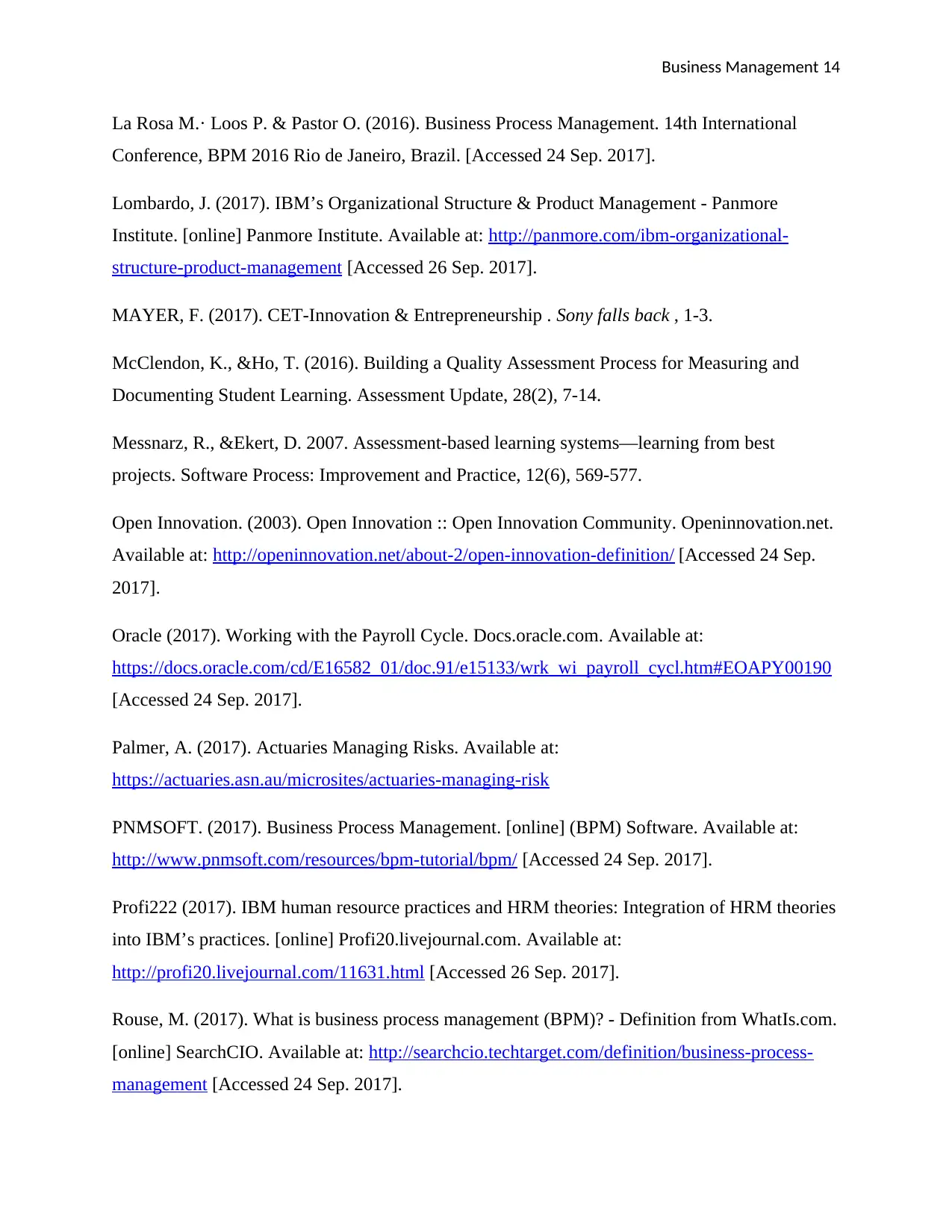
Business Management 14
La Rosa M.· Loos P. & Pastor O. (2016). Business Process Management. 14th International
Conference, BPM 2016 Rio de Janeiro, Brazil. [Accessed 24 Sep. 2017].
Lombardo, J. (2017). IBM’s Organizational Structure & Product Management - Panmore
Institute. [online] Panmore Institute. Available at: http://panmore.com/ibm-organizational-
structure-product-management [Accessed 26 Sep. 2017].
MAYER, F. (2017). CET-Innovation & Entrepreneurship . Sony falls back , 1-3.
McClendon, K., &Ho, T. (2016). Building a Quality Assessment Process for Measuring and
Documenting Student Learning. Assessment Update, 28(2), 7-14.
Messnarz, R., &Ekert, D. 2007. Assessment-based learning systems—learning from best
projects. Software Process: Improvement and Practice, 12(6), 569-577.
Open Innovation. (2003). Open Innovation :: Open Innovation Community. Openinnovation.net.
Available at: http://openinnovation.net/about-2/open-innovation-definition/ [Accessed 24 Sep.
2017].
Oracle (2017). Working with the Payroll Cycle. Docs.oracle.com. Available at:
https://docs.oracle.com/cd/E16582_01/doc.91/e15133/wrk_wi_payroll_cycl.htm#EOAPY00190
[Accessed 24 Sep. 2017].
Palmer, A. (2017). Actuaries Managing Risks. Available at:
https://actuaries.asn.au/microsites/actuaries-managing-risk
PNMSOFT. (2017). Business Process Management. [online] (BPM) Software. Available at:
http://www.pnmsoft.com/resources/bpm-tutorial/bpm/ [Accessed 24 Sep. 2017].
Profi222 (2017). IBM human resource practices and HRM theories: Integration of HRM theories
into IBM’s practices. [online] Profi20.livejournal.com. Available at:
http://profi20.livejournal.com/11631.html [Accessed 26 Sep. 2017].
Rouse, M. (2017). What is business process management (BPM)? - Definition from WhatIs.com.
[online] SearchCIO. Available at: http://searchcio.techtarget.com/definition/business-process-
management [Accessed 24 Sep. 2017].
La Rosa M.· Loos P. & Pastor O. (2016). Business Process Management. 14th International
Conference, BPM 2016 Rio de Janeiro, Brazil. [Accessed 24 Sep. 2017].
Lombardo, J. (2017). IBM’s Organizational Structure & Product Management - Panmore
Institute. [online] Panmore Institute. Available at: http://panmore.com/ibm-organizational-
structure-product-management [Accessed 26 Sep. 2017].
MAYER, F. (2017). CET-Innovation & Entrepreneurship . Sony falls back , 1-3.
McClendon, K., &Ho, T. (2016). Building a Quality Assessment Process for Measuring and
Documenting Student Learning. Assessment Update, 28(2), 7-14.
Messnarz, R., &Ekert, D. 2007. Assessment-based learning systems—learning from best
projects. Software Process: Improvement and Practice, 12(6), 569-577.
Open Innovation. (2003). Open Innovation :: Open Innovation Community. Openinnovation.net.
Available at: http://openinnovation.net/about-2/open-innovation-definition/ [Accessed 24 Sep.
2017].
Oracle (2017). Working with the Payroll Cycle. Docs.oracle.com. Available at:
https://docs.oracle.com/cd/E16582_01/doc.91/e15133/wrk_wi_payroll_cycl.htm#EOAPY00190
[Accessed 24 Sep. 2017].
Palmer, A. (2017). Actuaries Managing Risks. Available at:
https://actuaries.asn.au/microsites/actuaries-managing-risk
PNMSOFT. (2017). Business Process Management. [online] (BPM) Software. Available at:
http://www.pnmsoft.com/resources/bpm-tutorial/bpm/ [Accessed 24 Sep. 2017].
Profi222 (2017). IBM human resource practices and HRM theories: Integration of HRM theories
into IBM’s practices. [online] Profi20.livejournal.com. Available at:
http://profi20.livejournal.com/11631.html [Accessed 26 Sep. 2017].
Rouse, M. (2017). What is business process management (BPM)? - Definition from WhatIs.com.
[online] SearchCIO. Available at: http://searchcio.techtarget.com/definition/business-process-
management [Accessed 24 Sep. 2017].
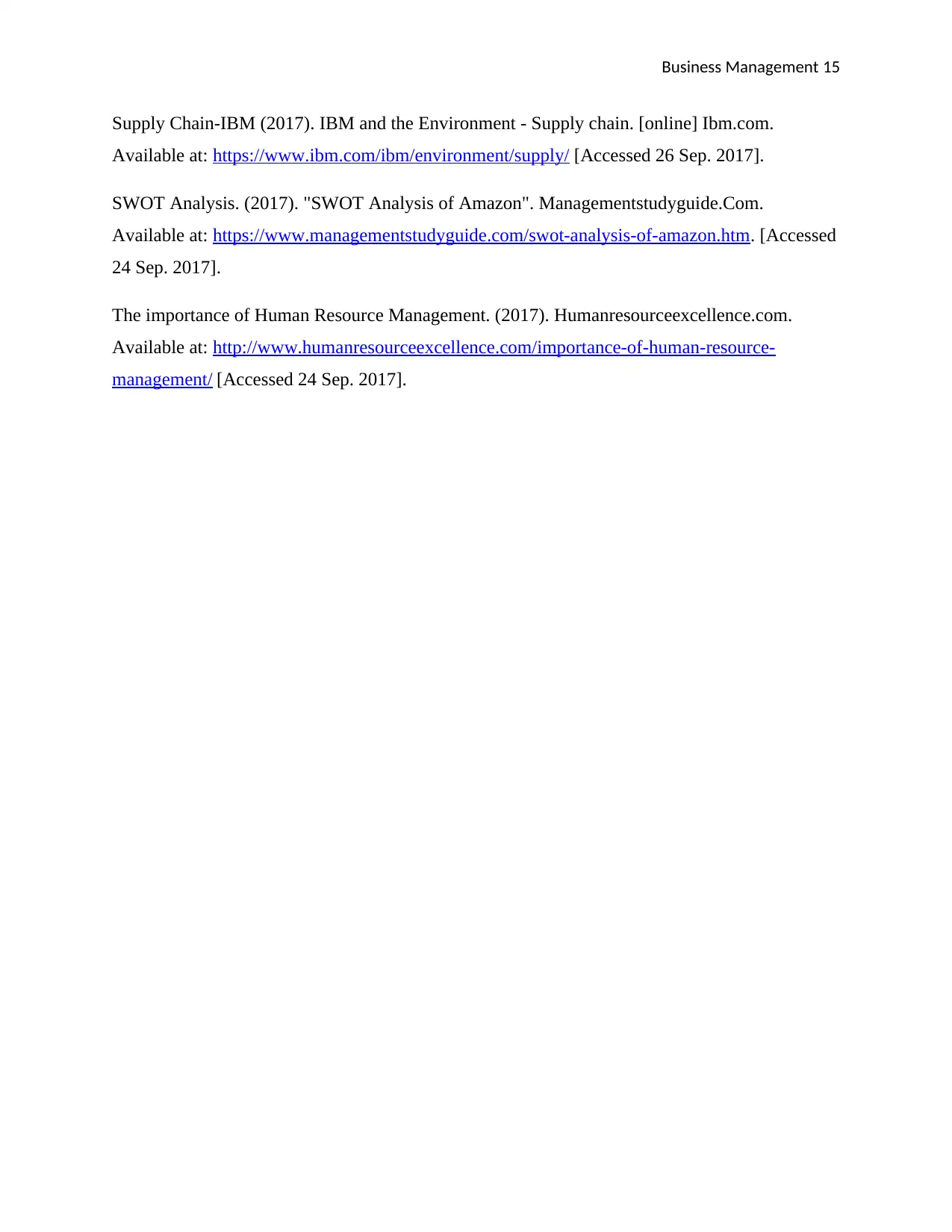
Business Management 15
Supply Chain-IBM (2017). IBM and the Environment - Supply chain. [online] Ibm.com.
Available at: https://www.ibm.com/ibm/environment/supply/ [Accessed 26 Sep. 2017].
SWOT Analysis. (2017). "SWOT Analysis of Amazon". Managementstudyguide.Com.
Available at: https://www.managementstudyguide.com/swot-analysis-of-amazon.htm. [Accessed
24 Sep. 2017].
The importance of Human Resource Management. (2017). Humanresourceexcellence.com.
Available at: http://www.humanresourceexcellence.com/importance-of-human-resource-
management/ [Accessed 24 Sep. 2017].
Supply Chain-IBM (2017). IBM and the Environment - Supply chain. [online] Ibm.com.
Available at: https://www.ibm.com/ibm/environment/supply/ [Accessed 26 Sep. 2017].
SWOT Analysis. (2017). "SWOT Analysis of Amazon". Managementstudyguide.Com.
Available at: https://www.managementstudyguide.com/swot-analysis-of-amazon.htm. [Accessed
24 Sep. 2017].
The importance of Human Resource Management. (2017). Humanresourceexcellence.com.
Available at: http://www.humanresourceexcellence.com/importance-of-human-resource-
management/ [Accessed 24 Sep. 2017].
1 out of 15
Related Documents
Your All-in-One AI-Powered Toolkit for Academic Success.
+13062052269
info@desklib.com
Available 24*7 on WhatsApp / Email
![[object Object]](/_next/static/media/star-bottom.7253800d.svg)
Unlock your academic potential
© 2024 | Zucol Services PVT LTD | All rights reserved.





